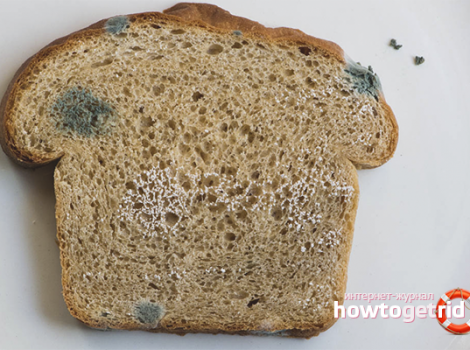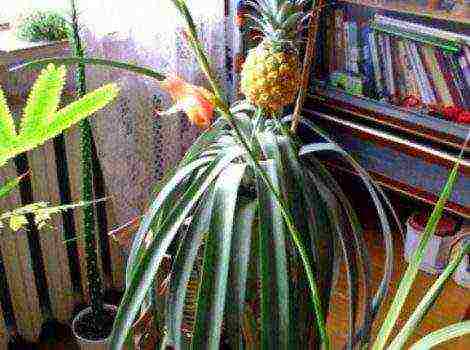Content
- 1 How to care for a plant at home
- 2 How to plant correctly?
- 3 Reproduction methods
- 4 Proper maintenance in the garden
- 5 Laurel - houseplant
- 6 Growing laurel from seeds
- 7 How to propagate bay leaves at home
- 8 Recommendations for proper cultivation
- 9 Characteristics
The use of bay leaves in cooking has become a tradition; no hot dish can do without it. But not many people know that you can grow bay leaves at home. It will perfectly enliven the home interior and fit into the landscape design of the garden area.
Laurel noble adapts to any place of stay. Some tricks and rules for caring for a plant make it possible to grow a beautiful green shrub even in the open field.
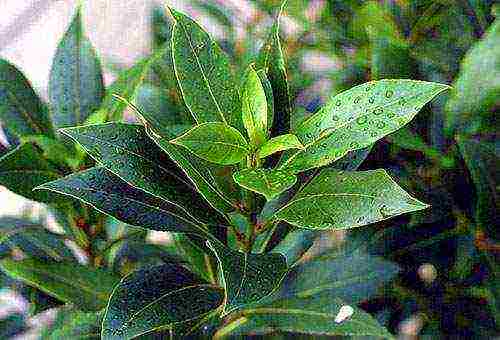
How to care for a plant at home
If you decide to grow laurel at home, you need to find a suitable place for it.
- You need to place the plant on a windowsill or on a flower stand, where there is a lot of light and sun. In the shade, the plant develops more slowly. Do not expose foliage to direct sunlight.
- Ventilate the room often to prevent discoloration and drying of the leaf tips.
- Water as the soil dries. The tree requires good drainage so that the root system does not rot from excess moisture. A refreshing shower and spraying will moisturize the crown and avoid pest infestation.
Advice
For watering, it is recommended to use a water solution with baking soda. To prepare it, you will need 1 liter. running water and ½ teaspoon of soda.
- It is worth maintaining the average temperature in the room, not higher than 25 degrees, in the cold season, the laurel should arrange a winter period at home, when the temperature of the content is 10-14 degrees, and watering is reduced and carried out once every 2 weeks.
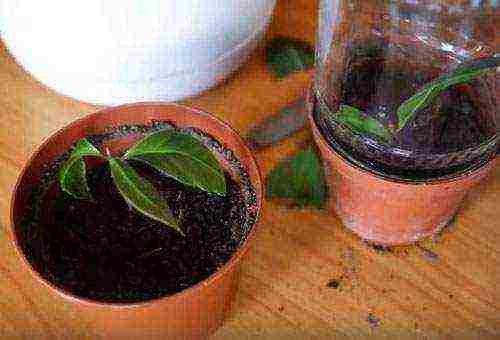
How to plant correctly?
The growth and development of the plant depends on the correct planting. Before starting, it is necessary to prepare all the components of the process: layering, pot, soil, mineral fertilizer, drainage, shovel.
- Take a small pot, because the plant develops slowly, and a large container will inhibit growth.
- Pour drainage on the bottom (2–3 cm). You can take expanded clay or ordinary foam, which must first be broken into small pieces.
- Prepare an earthen mixture: sand (1 part), peat soil (1 part), leafy soil (2 parts), turf soil (4 parts) - and fill the pot halfway.
- Place bay leaf in the middle, cover with mixture and tamp lightly.
- Water the plant with the diluted mineral complex.
Transplanting a plant at home into a new pot is done once every 2.5–3 years due to the slow development of the root system and the upper part.
An adult tree is transplanted every 4 years or the top layer is renewed every 2 years. In the warm season, the plant can be placed outdoors.
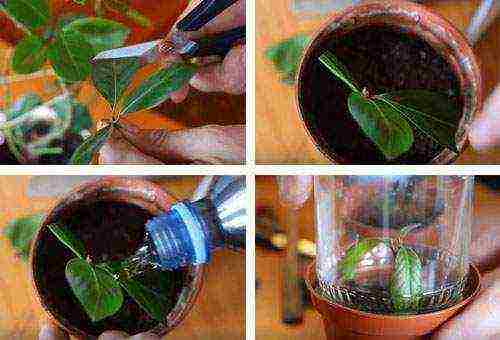
Reproduction methods
There are several ways to propagate a noble laurel at home:
- cuttings;
- planting seeds;
- separation of offspring.
Reproduction requires not only experience and skill, but also patience.
Cutting is one of the most time consuming methods, using a large, sturdy tree. To do this, you need to proceed according to the following algorithm.
- Separate the twigs with 4 internodes neatly with a utility knife or blade.
- Dip each of them in a substance for active growth of the root system (you can find it in any specialty store). Place in a container of water until roots form. Cuttings can be placed in moist perlite by covering the top with a glass jar. The plant must be periodically ventilated to prevent decay.
- After the roots appear, transplant into a ceramic or plastic pot.
Seed propagation is the longest process; seedlings may appear 60–65 days after planting.
Sowing should be carried out in early spring, as a soil, you can use a universal planting mixture. The seeds are placed at a depth of 1.5–2 cm, slightly moistened on top and covered with glass containers, which must be removed periodically to ventilate and moisten the soil.
Advice
Opt for fresh seeds that have been recently packed, because bay leaves tend to quickly lose germination quality.
Growing a leaf by separating the offspring is an easy and fast way to reproduce. When transplanting an adult plant, it is necessary to separate the “children” with roots from it and plant them in a separate small container.

Proper maintenance in the garden
Average frost resistance allows you to grow shrubs in the open field or in a greenhouse. Bay leaves can freeze at temperatures below 13-15 degrees.
Advice
If, nevertheless, you took the risk of purchasing a plant in a region where the temperature in winter drops below this norm, plant it in a wooden tub or garden pot. This will transport the laurel to a warmer location.
Conditions that must be observed when growing in the garden:
- choose a sunny place for planting;
- neutralize the acidity of the soil;
- provide moderate watering;
- timely feed the plant.
This plant easily tolerates pruning, therefore it is a favorite shrub of experienced gardeners. In the southern regions, laurel hedges are common, which are given various interesting shapes and adjusted to the design concept.
Bay leaf is an unpretentious plant, it can be grown with pleasure at home, with little experience in floriculture.
By planting a shrub outdoors, you will get a versatile decorative element in your garden plot. Simple rules for planting and caring for a plant will allow you to grow an environmentally friendly seasoning for culinary masterpieces at home.

Bay trees are cultivated in subtropical latitudes, and they grow there with pleasure. In Russia, laurels can be found in nature in the southwest of the Krasnodar Territory. However, like many other thermophilic plants, laurel can be grown at home. You just need to carefully consider the needs of this Mediterranean miracle and take care of it in the same way we take care of fish, parrots and other pets. Bay trees are cultivated in subtropical latitudes, and they grow there with pleasure.
 Bay leaf growing at home In Russia, laurels can be found in nature in the southwest of the Krasnodar Territory. However, like many other thermophilic plants, laurel can be grown at home. You just need to carefully consider the needs of this Mediterranean miracle and take care of it in the same way we take care of fish, parrots and other pets.
Bay leaf growing at home In Russia, laurels can be found in nature in the southwest of the Krasnodar Territory. However, like many other thermophilic plants, laurel can be grown at home. You just need to carefully consider the needs of this Mediterranean miracle and take care of it in the same way we take care of fish, parrots and other pets.
Laurel - houseplant
 Laurel houseplant Fresh laurel leaves have a calm pleasant green color that will enliven any interior.Fragrant leaves will freshen and purify the air in the house, thanks to their ability to release phytoncides, which inhibit the development of bacteria and fungi.
Laurel houseplant Fresh laurel leaves have a calm pleasant green color that will enliven any interior.Fragrant leaves will freshen and purify the air in the house, thanks to their ability to release phytoncides, which inhibit the development of bacteria and fungi.
Laurel is a rather unpretentious plant. It is not as picky about growing conditions as lemon, for example. And if you plant a bay leaf at home, it will thrive even in the northern part of the house in less light conditions. But still, with sufficient illumination, the plant will turn out to be much lush and thicker.
The full-fledged bay leaves that are used in cooking will appear on your personal bay tree within two years. It is at this age that the leaves acquire a rich aroma. In indoor conditions, laurel grows up to two meters, and with especially good care, even higher. So you can generously share your own bay leaf harvest with your friends.
For laurel, propagation by seeds, layering, cuttings and seedlings is acceptable.
 Laurel noble
Laurel noble
Growing laurel from seeds
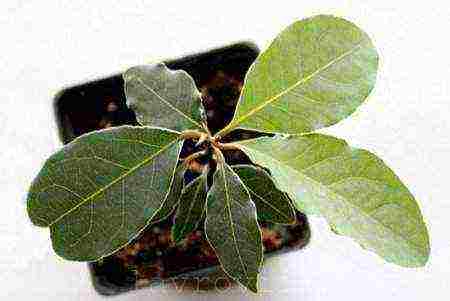 Cultivation of laurel from seeds The method of growing laurel with seeds is the most reliable, since the development of young plants from the very beginning occurs in the same conditions, and therefore they are not subjected to special stresses.
Cultivation of laurel from seeds The method of growing laurel with seeds is the most reliable, since the development of young plants from the very beginning occurs in the same conditions, and therefore they are not subjected to special stresses.
Laurel seeds can be found in flower shops or ordered online. Great luck and almost one hundred percent guarantee - freshly harvested seeds. But in any case, before sowing, you need to store the seeds in the refrigerator. This is the key to their best germination. In addition, laurel seeds have a thick skin, and in order to facilitate the emergence of a sprout, the seeds are soaked for several days. To accelerate germination and stimulate growth, it can be soaked in a special activating solution. For example, the growth drug "Epin" has shown itself to be excellent.
Any fertile soil is prepared for sowing seeds, but the top layer in a 2-3 cm thick container must be steamed or calcined sand. This is the best environment for the development of laurel seeds.
Seed peas are planted to a depth of 1 cm and covered with foil to retain moisture in the soil. Seeds germinate for a long time, up to several months. If you have patience and treat this process with love, they will surely hatch.
The optimal period for sowing seeds is during the winter months (January, February). Then, even if the seeds are late and lie in the ground for six whole months before germination, they will begin to develop in a favorable period both in temperature and in light.
And when this happens, they remove the film from the greenhouse and wait for the formation of the first leaves. Small laurels with two leaves can already be transplanted into a separate pot.
The site has detailed instructions for growing laurel from seeds.
How to propagate bay leaves at home
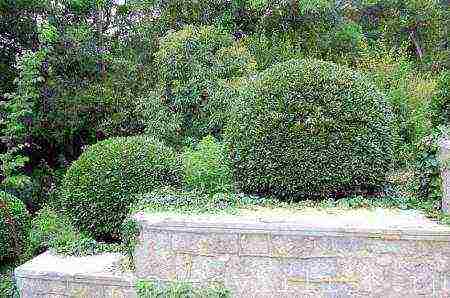 How to propagate bay leaves at home
How to propagate bay leaves at home
Growing laurel from cuttings
 Growing laurel from cuttings Growing a plant from cuttings is a more laborious process than sowing seeds. Laurel cuttings are harvested from an adult plant in the spring, when the trees wake up after winter, or in the first half of summer. Very successful cuttings are obtained from annual shoots that have not had time to lignify. The branches are cut into 6-8cm pieces.
Growing laurel from cuttings Growing a plant from cuttings is a more laborious process than sowing seeds. Laurel cuttings are harvested from an adult plant in the spring, when the trees wake up after winter, or in the first half of summer. Very successful cuttings are obtained from annual shoots that have not had time to lignify. The branches are cut into 6-8cm pieces.
Each cutting should have three internodes, that is, three free areas between the places of attachment of the leaves. For grafting, it is better to use the lower or middle part of the branch. Each stalk should have an oblique cut below. Then the first leaves must be removed, and the top ones must be cut off, leaving half a leaf - in order to minimize moisture evaporation.  Pruning bay leaves
Pruning bay leaves
Any soil is suitable for bay leaves, but for planting cuttings it is better to prepare a nutritious substrate of your choice:
a mixture of 1 part of leafy soil with 1 part of marsh moss;
a mixture of 1 part of sod land and 1 part of sand;
a mixture of 1 part sand and 1 part moss;
just coarse sand.
Bay plants are very tolerant of any soil. The only thing they cannot stand is excessive waterlogging. So, almost the main condition for the successful cultivation of laurel is good drainage.
It is advisable to steam the prepared soil in order to avoid damage to the cuttings by pathogenic bacteria. The sand can be ignited. Any suitable drainage is placed at the bottom of the container.
For better rooting, you can use special stimulants that promote root formation. Powder Kornevin is suitable for this purpose. The lower part of the cutting should be dipped in the growth preparation powder. And you can withstand the bases of the cuttings (immersed by 2-3 cm) for a day in a special solution of heteroauxin. The roots from such a procedure will turn out to be well branched and strong. Some gardeners use phytohormones for better rooting, and also organize bottom heating for cuttings.
The cuttings are buried 1.5 cm in the ground. They need to be provided with watering and a temperature of at least 22 degrees. To maintain the temperature regime, the cuttings are covered with a suitable transparent material: film, glass or a jar. Every day, the shelter needs to be briefly removed or opened for ventilation. It is useful not only to water the cuttings, but also to spray them with water. The first three weeks - this should be done 4-5 times a day. Then the number of sprays is gradually reduced.
It will take about one month for rooting. Once the plants have taken root, you can transplant them into another container. For the substrate, garden or sod land, leaf land and sand are taken. You can add a little peat and lime (5-10g).
Growing seedlings from horizontal layers
 Growing seedlings from horizontal layers A laurel tree can be grown from a layer as is done with grapes. Take one of the lower branches, put it in a groove, pin it to the ground and sprinkle it with soil. In the place where the branch will cover the ground, you need to make an incision or at least a scratch on the bark.
Growing seedlings from horizontal layers A laurel tree can be grown from a layer as is done with grapes. Take one of the lower branches, put it in a groove, pin it to the ground and sprinkle it with soil. In the place where the branch will cover the ground, you need to make an incision or at least a scratch on the bark.
A prerequisite for successful germination is a sufficient amount of moisture.
As soon as a green sprout appears from under the ground, you can dig out a layer and cut it off from the main branch. Then plant the young plant in a separate container.
Growing laurel seedlings
 Growing laurel seedlings Buying ready-made laurel seedlings is no longer a problem. And the price for them is very democratic.
Growing laurel seedlings Buying ready-made laurel seedlings is no longer a problem. And the price for them is very democratic.
As soon as pets appear in the house, they need to be placed where there is diffused lighting or partial shade. At least they don't need direct sunlight for the acclimatization period.
It should also be the coolest place in the house, since laurel is not one of those who love high temperatures. A pleasant thermal regime for laurel is 15-20 degrees in summer and 10-12 in winter.
Laurel loves humid air. Therefore, it can be humidified in different ways: by spraying, containers with water next to the pot, shower.
When the time comes to pinch and prune bay trees, move them to a lighter spot for better branching.
Recommendations for proper cultivation
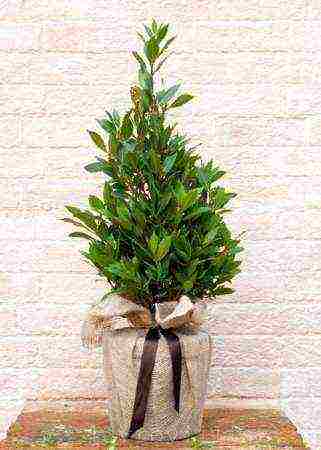 Recommendations for the correct cultivation of laurel Laurel responds well to organic fertilizers. This could be, for example, pigeon droppings. It is diluted with water, preferably settled. For one part of the litter, take 20 parts of water. Laurel will also accept mineral fertilizers well. You can feed him once every three weeks.
Recommendations for the correct cultivation of laurel Laurel responds well to organic fertilizers. This could be, for example, pigeon droppings. It is diluted with water, preferably settled. For one part of the litter, take 20 parts of water. Laurel will also accept mineral fertilizers well. You can feed him once every three weeks.
 Recommendations for the correct cultivation of bay leaves Laurel is very fond of water, so at least once a month he needs to arrange a warm refreshing shower. You also need to water the plant with warm, settled water. In the cold season, this is done once every five days, and in the warm season, more often - once every three days.
Recommendations for the correct cultivation of bay leaves Laurel is very fond of water, so at least once a month he needs to arrange a warm refreshing shower. You also need to water the plant with warm, settled water. In the cold season, this is done once every five days, and in the warm season, more often - once every three days.
Bay trees need to be replanted periodically.At a young age, the transplant is carried out after two years, and older trees need to be disturbed less often - once every five years. After transplanting, laurel does not need to be fertilized for about six months. But fresh air will not interfere with it. As long as the temperatures allow, the laurel can be kept on the balcony or in the garden, and brought into the room before winter.
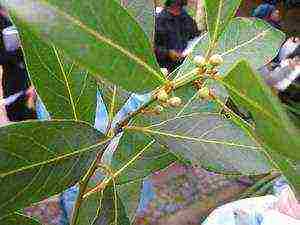 One of the most popular home-grown evergreens is the laurel flower. He may be a small bush or a miniature tree.
One of the most popular home-grown evergreens is the laurel flower. He may be a small bush or a miniature tree.
In ancient times, laurel wreaths were worn on the heads of winners and famous people. This plant is very convenient to grow at home, because, in addition to decorative decoration of the apartment, it also has useful functions. There is no need to run to the store for a bay leaf, you just need to pluck it from the tree.
Characteristics
Laurel is an easy-to-care indoor plant. Even a beginner in flower cultivation can do this. In nature the laurel tree grows very tall... There are specimens exceeding 18 meters. Today, in the Sochi forests, you can see a laurel reaching 15 meters in height.
Although this plant is not very pretentious, it requires a favorable environment for it to grow well. This houseplant is very fond of the sun's rays, but it can grow well in a shaded place.
 Laurel does not react to drafts, it is not afraid of drought. A laurel tree at home does not require much maintenance, it is necessary that there is always enough water, without waterlogging the soil.
Laurel does not react to drafts, it is not afraid of drought. A laurel tree at home does not require much maintenance, it is necessary that there is always enough water, without waterlogging the soil.
Homemade laurel copes well with diseases, is not afraid of pests. To give a certain shape, laurel bushes can be trimmed. WITHmodern gardeners manage to grow tall laurel trees, differing from their counterparts in an openwork, intricately intertwined trunk.
Types of indoor laurel
This plant is subdivided into two groups:
- Noble;
- Canary.
Canary laurel has wide, large leaves, the edges of which look somewhat wrinkled. This species loses to the noble laurel in terms of the strength of its aroma.
The main botanical variety of laurel is divided into three types:
- Narrow-leaved;
- Golden;
- Wrinkly.
Each variety is characterized by the shape of the leaf and its color.
How laurel is planted
 The noble laurel should be planted in early spring. If you have already grown laurel earlier, then you need to pick up a pot whose diameter is a couple of centimeters larger than the previous one.
The noble laurel should be planted in early spring. If you have already grown laurel earlier, then you need to pick up a pot whose diameter is a couple of centimeters larger than the previous one.
First, a drainage layer is placed in the pot. For this, you can use expanded clay or broken brick. The substrate is placed on this layer. For laurel, the soil should consist of sand, turf and leafy soil.... Such a composition is sold in the store, as land intended for breeding cacti.
Home laurel care
This houseplant is not very moody. But, it needs to be constantly sprayed and trimmed so that the crown has a decorative shape. It is also necessary to monitor the appearance of pests or diseases in order to prevent their development.
For good growth, the laurel does not interfere with a lot of sunlight at all. It can grow well in partial shade. Summer, when the temperature is more than 25 degrees, the bay bush can be left on the balcony... With proper care, indoor laurel can live for over 15 years.
In order to get a good growth of an indoor noble laurel, it is necessary to create conditions for him that resemble his native places. With the onset of cold weather, the optimal temperature in which a room laurel can safely be is 18 degrees.
Professionals recommend in January to lower the temperature to 10 degrees. In apartments where central heating works in winter, it is better to install laurel bushes away from heating radiators.
Where should the laurel bushes be in the apartment?
In order to grow a good laurel flower, it is very important to find the right location for it.It is desirable that the plant does not fall into drafts, the laurel does not like them. But you need to air the room with laurel regularly.
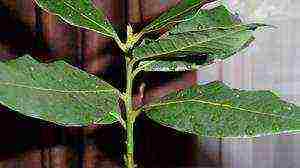 It is not required to create special lighting for the laurel. Normal room light is enough. To achieve the flowering of laurel at home, you need to take care of it, trying to bring the conditions of its location closer to real ones.
It is not required to create special lighting for the laurel. Normal room light is enough. To achieve the flowering of laurel at home, you need to take care of it, trying to bring the conditions of its location closer to real ones.
For example, a pot with a tree should be placed where there is a lot of light. So, with a large amount of scattered sunlight, laurel leaves will take on a more decorative look. The bush will be very dense, which rarely happens if the bay tree grows in more shaded areas.
How to water laurel bushes
In the spring and summer, the bushes need to be watered regularly. When it is very hot outside, watering should be more vigorous. But, prolonged waterlogging should not be allowed, because stagnation of water in the soil can lead to rotting of the roots and death of the plant.
The watering schedule in the winter is very different from the summer. The substrate needs to be watered only after the top layer of soil in the pot begins to dry... Watering should be done with well-settled water at room temperature.
With the onset of heat, the noble laurel should be sprayed in the morning and evening hours. You can also place a container of water near a bay pot.
Experienced florists use another method. Pebbles are poured into the pallet, then it is filled with water, a pot of laurel is placed on top.
How laurel reproduces
Usually propagation of this unpretentious plant is carried out by cuttings, but you can propagate laurel and seeds.
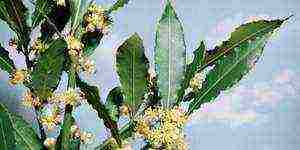 To grow laurel from seeds, you need to have special soil. To obtain rapid growth, it is recommended to pre-soak the seeds in heated water and hold for a couple of hours.
To grow laurel from seeds, you need to have special soil. To obtain rapid growth, it is recommended to pre-soak the seeds in heated water and hold for a couple of hours.
The seeds do not need to be buried deep in the soil. It is enough to sprinkle them with earth and cover with foil.
When laurel propagates by cuttings, they must be cut off from shoots that did not have time to completely lignify.
With the onset of spring, the cut off shoots are planted in slightly moistened soil. It is advisable to remove all leaves from the trunk, leaving two or three. The length of the handle should not exceed 8 cm... For the plant to take root faster, it is worth using wet sand. Usually young seedlings take root well within one month.
How is the transplant done
This operation does not need to be performed very often. A small tree should not be transplanted into a large pot. Laurel will do great in a small pot.
When he grows up and the pot becomes cramped for him, another container is taken, with a large diameter of about 4 cm.
The transplant is performed by rearranging the earthen coma. The missing soil is poured into the pot. Then the transplanted laurel water well. Transfer work usually performed in spring or summer.
Problems that may arise when growing
When decorative laurel is grown at home, the appearance of pests and tree diseases is possible. Several types of parasites can cause serious harm to the plant:
- Shield;
- Spider mite;
- Mealybug.
 The bay bush is usually attacked by fungal diseases. This may be due to excess watering. At this time, brown spots appear on the bay leaf.
The bay bush is usually attacked by fungal diseases. This may be due to excess watering. At this time, brown spots appear on the bay leaf.
To fight such diseases, you need removal of damaged areas and plant transplant, with the addition of a new fresh substrate.
If you follow all the rules for growing laurel at home, you can always have a beautiful, fragrant and healthy plant in the room.
How to grow bay leaves at home
Not a single housewife in her kitchen can do without bay leaves. We use this popular herb as an aromatic herb, as well as for medicinal and cosmetic purposes. It is very affordable and we can get it in any store.But it is much more pleasant to use the useful leaves of laurel, which is grown on your own windowsill!
Despite the fact that the Mediterranean lands are the birthplace of laurel, it develops perfectly in the conditions of our apartments. And already for 3-4 years of life, you can collect and dry leaves rich in valuable substances, essential oil and various acids. In addition, an adult plant looks very beautiful and can be a real decoration for your winter garden.
How to care?
Before figuring out how to grow a bay leaf at home, you need to understand if you can provide the plant with the proper conditions. The tree itself can adapt to both sunny and darkened rooms. But if the house has a balcony, then in the summer it is advisable to take the plant out into the air. A garden or suburban area for this purpose would be the best option. In winter, place your laurel in a bright room.
Growing bay leaves does not require any special skills and knowledge. You just need to water the plant as the earthen coma dries out more often in summer, less often in winter, and spray the leaves with lukewarm water on the hottest days. Laurel should be watered with water at room temperature, he will not like cold water. And once a month, the plant should be fed so that it develops well and grows stronger. For this purpose, such concentrated mixtures as "Cactus" or "Palm" and the like are perfect.
Carbonate, light soil is what you need for planting laurel. In specialized stores you can buy ready-made mixture "Cactus", in which your plant will develop very well. From the moment of planting, you will have to replant the laurel every year in a new pot. When the tree reaches 5 years of age, you can change the land once in a four-year period.
Growing bay leaves from seeds
It is quite simple to grow laurel from seeds at home. Such a plant will adapt better to the new life, and will be able to develop well. Seeds are planted in the spring or fall. If you were able to get the seeds at the wrong time for germination, it is better not to risk it and hide them for several months in a cold place, sprinkled with sand.
Seed growing takes place in several stages:
- To begin with, the seeds are placed in small boxes. The soil in these containers should consist of a sod, leaf mixture, mixed with sand (1: 1: 0.5). Before planting, the seeds are freed from the surrounding pulp, and at the end of the procedure, they are covered with glass (you can use plastic wrap).
- When your seeds germinate and give 2 leaves each, they can be transplanted into separate small pots (you don't have to buy ready-made containers in the store - used yogurt cups, etc.).
- The grown and matured plants are transplanted into ceramic pots until further growth.
Propagation by cuttings
If you do not know how to grow a bay leaf at home without seeds, then you can prepare cuttings for this purpose. The process of preparing cuttings should begin no earlier than March-April. Shoots are used only from a healthy bush that has already matured, but has not yet been covered with a crust.
Cuttings are cut into small pieces of 6-8 cm, observing some rules: when cutting off the cutting, you do not need to completely cut it off with a knife. Make an incision, and then gently tear off a piece to capture some of the crust. The stalk should have a heel starting below the first knot. Pouring at the bottom of the cutting is removed.
Growing bay leaves from cuttings is not an easy task. Cuttings root poorly, therefore it is recommended to use drugs that stimulate the process of root formation to form the root system. Before lowering the cuttings into the composition, they should be wetted.Something special is not required to remove excess preparation - you just need to shake off the cuttings.
The stalk prepared in this way is planted in a kind of greenhouse: under a plastic wrap supported by pegs, in clean sand, about 2 cm. in depth. You should wait for the rooting of cuttings no earlier than a month later. Then they can be planted in the ground.
An adult plant can be given absolutely any shape as a decoration for a room. You can trim your tree in the shape of a ball, or in the shape of an animal. Already from 2 years of age, the crown of a tree can be formed.
By growing a bay leaf yourself in your own apartment, you will not only get a wonderful decoration, but also a home remedy and an exquisite seasoning. We wish you every success!
Svetlana Frantseva "How to grow a bay leaf at home" specially for the Eco-life website.
Photo: Alexey Korostiy
More about unusual home plants:
How to grow pineapple at home
How to grow a date palm from a seed
